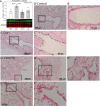Proteomic profiling of tracheal fluid in an ovine model of congenital diaphragmatic hernia and fetal tracheal occlusion
- PMID: 30260286
- PMCID: PMC6337007
- DOI: 10.1152/ajplung.00148.2018
Proteomic profiling of tracheal fluid in an ovine model of congenital diaphragmatic hernia and fetal tracheal occlusion
Abstract
Congenital diaphragmatic hernia (CDH) occurs in ~1:2,000 pregnancies and is associated with substantial morbidity and mortality. Fetal tracheal occlusion (TO) is an emerging therapy that improves lung growth and reduces mortality, although substantial respiratory compromise persists in survivors. In this study, we used tracheal fluid in a fetal sheep model of CDH with TO for proteomic analysis with subsequent validation of findings in sheep lung tissue. We found that the proteomic profiles of CDH tracheal fluid was most similar to control lung and CDH/TO lung most similar to TO lung. Among 118 proteins altered in CDH, only 11 were reciprocally regulated in CDH/TO. The most significantly altered pathways and processes were cell proliferation, phosphatidylinositol 3-kinase/AKT/mammalian target of rapamycin signaling, inflammation, and microtubule dynamics. CDH suppressed and TO promoted cell proliferation and AKT-related signaling cascades. By Western blot analysis and immunohistochemistry, epithelial PCNA and phosphorylated AKT were decreased in CDH and increased in TO and CDH/TO lungs. The Wnt target Axin2 was decreased threefold in CDH lung compared with control without a significant increase in CDH/TO lung. Cilia-related pathways were among the most dysregulated with CDH lung having a nearly twofold increase in acetylated α-tubulin and a relative increase in the number of ciliated cells. While TO improves lung growth and patient survival in CDH, the procedure substantially alters many processes important in lung development and cell differentiation. Further elucidation of these changes will be critical to improving lung health in infants with CDH treated with TO.
Keywords: cell differentiation; cell proliferation; fetal surgery; lung development.
Figures







Similar articles
-
Increased TGF-β: a drawback of tracheal occlusion in human and experimental congenital diaphragmatic hernia?Am J Physiol Lung Cell Mol Physiol. 2016 Feb 15;310(4):L311-27. doi: 10.1152/ajplung.00122.2015. Epub 2015 Dec 4. Am J Physiol Lung Cell Mol Physiol. 2016. PMID: 26637634
-
The effects of tracheal occlusion on Wnt signaling in a rabbit model of congenital diaphragmatic hernia.J Pediatr Surg. 2019 May;54(5):937-944. doi: 10.1016/j.jpedsurg.2019.01.024. Epub 2019 Jan 31. J Pediatr Surg. 2019. PMID: 30792093
-
Fetal Tracheal Occlusion Correlates with Normalized YAP Expression and Alveolar Epithelial Differentiation in Congenital Diaphragmatic Hernia.Am J Respir Cell Mol Biol. 2025 Jun;72(6):688-697. doi: 10.1165/rcmb.2024-0323OC. Am J Respir Cell Mol Biol. 2025. PMID: 39661950 Free PMC article.
-
Congenital diaphragmatic hernia: pathogenesis, prenatal diagnosis and management - literature review.Ginekol Pol. 2017;88(1):24-30. doi: 10.5603/GP.a2017.0005. Ginekol Pol. 2017. PMID: 28157247 Review.
-
Management of prenatally diagnosed congenital diaphragmatic hernia.Semin Fetal Neonatal Med. 2010 Feb;15(1):21-7. doi: 10.1016/j.siny.2009.07.012. Epub 2009 Nov 2. Semin Fetal Neonatal Med. 2010. PMID: 19884051 Review.
Cited by
-
The effect of tracheal occlusion in congenital diaphragmatic hernia in the nitrofen rat lung explant model.Pediatr Surg Int. 2022 Dec 23;39(1):61. doi: 10.1007/s00383-022-05340-7. Pediatr Surg Int. 2022. PMID: 36564649
-
A Tracheal Aspirate-derived Airway Basal Cell Model Reveals a Proinflammatory Epithelial Defect in Congenital Diaphragmatic Hernia.Am J Respir Crit Care Med. 2023 May 1;207(9):1214-1226. doi: 10.1164/rccm.202205-0953OC. Am J Respir Crit Care Med. 2023. PMID: 36731066 Free PMC article.
-
Epithelial Dysfunction in Congenital Diaphragmatic Hernia: Mechanisms, Models and Emerging Therapies.Cells. 2025 May 9;14(10):687. doi: 10.3390/cells14100687. Cells. 2025. PMID: 40422190 Free PMC article. Review.
-
Nuclear Factor-κB Keeps Basal Cells Undifferentiated in Congenital Diaphragmatic Hernia.Am J Respir Crit Care Med. 2023 May 1;207(9):1122-1123. doi: 10.1164/rccm.202302-0290ED. Am J Respir Crit Care Med. 2023. PMID: 36883942 Free PMC article. No abstract available.
-
A proteome signature of umbilical cord serum associated with congenital diaphragmatic hernia.Nagoya J Med Sci. 2020 May;82(2):345-354. doi: 10.18999/nagjms.82.2.345. Nagoya J Med Sci. 2020. PMID: 32581413 Free PMC article.
References
-
- Bioinformatics and Research Computing 3 Way Venn Diagram Generator http://barc.wi.mit.edu/tools/. [16 Mar 2016].
Publication types
MeSH terms
Substances
Grants and funding
LinkOut - more resources
Full Text Sources
Other Literature Sources
Medical
Miscellaneous

